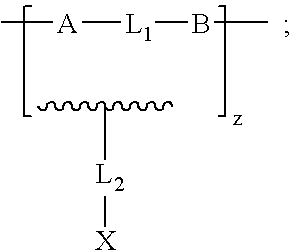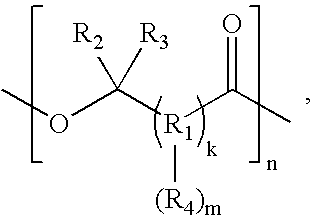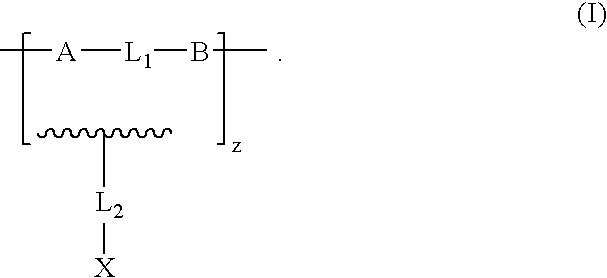Poly(hydroxyalkanoate-co-ester amides) and agents for use with medical articles
a technology of hydroxyalkanoate and coester amide, which is applied in the field of polymer polymers for use with medical articles, can solve the problems of insufficient mechanical properties of poly(hydroxyalkanoate) currently available, insufficient mechanical properties of many stent applications, and inability to meet the requirements of biodegradable coating release rate and absorption rate,
- Summary
- Abstract
- Description
- Claims
- Application Information
AI Technical Summary
Problems solved by technology
Method used
Image
Examples
example 1
[0236]Preparation of Carboxyl-Terminated, Hydroxyl-Terminated, and Amino-Terminated PHAs
[0237]A hydroxyl-terminated PHA can be prepared by several routes. In one route, a hydroxyl-acid compound such as lactic acid or ε-hydroxycaproic acid can be polymerized using acid catalysis, and dehydrating conditions, to produce a low molecular weight PHA with a hydroxyl and a carboxyl endgroup. In the presence of coupling agents such as DCC, an amine-hydroxyl compound such as ethanolamine can be coupled to the carboxyl endgroup resulting in a hydroxyl endgroup. Using the same PHA with a hydroxyl and carboxyl endgroups, the carboxyl endgroup can be selectively reduced to hydroxyl with borane. In another route, ring opening polymerization can be performed using a dihydric initiator, such as a diol, and a cyclic lactone.
[0238]1,6-hexanediol (14.77 gm (0.125 mole) can be added to a 250 ml, three-necked flask equipped with magnetic stirring, vacuum, and argon purge. Using an oil bath, the diol can ...
example 2
[0243]Preparation of the p(HA-EA) of Formula (XVII)
[0244]Three components are needed to prepare this polymer: a PHA with carboxyl and hydroxyl endgroups, a benzyl ester protected lysine, and sebacoyl chloride.
[0245]Preparation of Poly(Caprolactone) with Carboxyl and Hydroxyl Endgroups
[0246]ε-hydroxycaproic acid (100 gm, 0.757 mole), p-toluenesulfonic acid monohydrate (14.39 gm, 0.0757 mole), and toluene (350 ml) can be added to a 1000 ml, three necked flask equipped with argon purge, mechanical stirrer, oil bath, and Dean-Stark trap with reflux condenser. The solution can be heated to reflux, and the reaction can be run until 12.26 ml of water is collected in the Dean-Stark trap, indicating a polymer of approximately 1158 Daltons molecular weight. After cooling, the solution can be added to deionized water (500 ml) and stirred for 20 minutes. The toluene layer can be isolated and extracted with 1 N sodium bicarbonate (400 ml), followed by two portions of deionized water (400 ml). Af...
example 3
[0254]Preparation of the p(HA-EA) of Formula (XIX)
[0255]This preparation begins with the co-poly[N,O-adipoyl-L-lysine-polycaprolactone] possessing a free carboxyl from Example 2. Co-poly[N,O-adipoyl-L-lysine-polycaprolactone] (10 gm, 0.00689 moles carboxyl groups), 4-hydroxyl-2,2,6,6-tetramethylpiperidinyl-1-oxyl (1.19 gm, 0.00689 mole) and anhydrous THF (90 ml) can be added to a 3-necked, 250 ml flask equipped with magnetic stirrer, argon inlet, ice bath, and 25 ml addition funnel. After dissolution, dicyclohexylcarbodiimide (1.56 gm, 0.00758 mole) can be added, and the solution can be stirred under argon at ambient temperature for 24 hours. After filtration to remove the dicyclohexylurea, the polymer can be precipitated by slow addition to isopropylacetate (500 ml). The remaining solvent can be removed by drying at about 40° under a vacuum of about 1 torr for about 48 hours to yield a polymer of formula (XIX).
PUM
| Property | Measurement | Unit |
|---|---|---|
| length | aaaaa | aaaaa |
| molecular weight | aaaaa | aaaaa |
| molecular weight | aaaaa | aaaaa |
Abstract
Description
Claims
Application Information
 Login to View More
Login to View More - R&D
- Intellectual Property
- Life Sciences
- Materials
- Tech Scout
- Unparalleled Data Quality
- Higher Quality Content
- 60% Fewer Hallucinations
Browse by: Latest US Patents, China's latest patents, Technical Efficacy Thesaurus, Application Domain, Technology Topic, Popular Technical Reports.
© 2025 PatSnap. All rights reserved.Legal|Privacy policy|Modern Slavery Act Transparency Statement|Sitemap|About US| Contact US: help@patsnap.com



